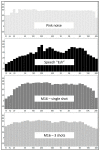Measuring "Where": A Comparative Analysis of Methods Measuring Spatial Perception
- PMID: 38067807
- PMCID: PMC10708821
- DOI: 10.3390/s23239434
Measuring "Where": A Comparative Analysis of Methods Measuring Spatial Perception
Abstract
The literature offers various methods for measuring sound localization. In this study, we aimed to compare these methods to determine their effectiveness in addressing different research questions by examining the effect sizes obtained from each measure. Data from 150 participants who identified the location of a sound source were analyzed to explore the effects of speaker angle, stimuli, HPD type, and condition (with/without HPD) on sound localization, using six methods for analysis: mean absolute deviation (MAD), root-mean-squared error (RMSE), very large errors (VLE), percentage of errors larger than the average error observed in a group of participants (pMean), percentage of errors larger than half the distance between two consecutive loudspeakers (pHalf), and mirror image reversal errors (MIRE). Results indicated that the MIRE measure was the most sensitive to the effects of speaker angle and HPD type, while the VLE measure was most sensitive to the effect of stimuli type. The condition variable provided the largest effect sizes, with no difference observed between measures. The data suggest that when effect sizes are substantial, all methods are adequate. However, for cases where the effect size is expected to be small, methods that yield larger effect sizes should be considered, considering their alignment with the research question.
Keywords: mean absolute deviation (MAD); measuring methods; mirror image reversal errors (MIRE); root-mean-squared error (RMSE); sound localization.
Conflict of interest statement
The authors declare no conflict of interest.
Figures




Similar articles
-
Situational Awareness: The Effect of Stimulus Type and Hearing Protection on Sound Localization.Sensors (Basel). 2021 Oct 24;21(21):7044. doi: 10.3390/s21217044. Sensors (Basel). 2021. PMID: 34770351 Free PMC article.
-
Small class sizes for improving student achievement in primary and secondary schools: a systematic review.Campbell Syst Rev. 2018 Oct 11;14(1):1-107. doi: 10.4073/csr.2018.10. eCollection 2018. Campbell Syst Rev. 2018. PMID: 37131395 Free PMC article.
-
Sound localization skills in children who use bilateral cochlear implants and in children with normal acoustic hearing.Ear Hear. 2010 Oct;31(5):645-56. doi: 10.1097/AUD.0b013e3181e50a1d. Ear Hear. 2010. PMID: 20592615 Free PMC article.
-
Sound Localization and Speech Perception in Noise of Pediatric Cochlear Implant Recipients: Bimodal Fitting Versus Bilateral Cochlear Implants.Ear Hear. 2017 Jul/Aug;38(4):426-440. doi: 10.1097/AUD.0000000000000401. Ear Hear. 2017. PMID: 28085740
-
Sound Localization in Toddlers with Normal Hearing and with Bilateral Cochlear Implants Revealed Through a Novel "Reaching for Sound" Task.J Am Acad Audiol. 2020 Mar;31(3):195-208. doi: 10.3766/jaaa.18092. Epub 2019 Aug 12. J Am Acad Audiol. 2020. PMID: 31429402 Free PMC article.
References
-
- Gelfand S.A. Hearing: An Introduction to Psychological and Physiological Acoustics. CRC Press; Cambridge, MA, USA: 2017.
LinkOut - more resources
Full Text Sources

